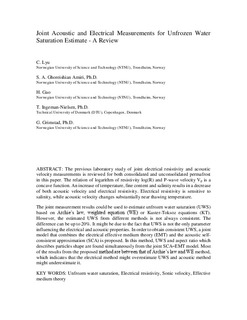| dc.contributor.author | Lyu, Chuangxin | |
| dc.contributor.author | Ghoreishian Amiri, Seyed Ali | |
| dc.contributor.author | Gao, Hao | |
| dc.contributor.author | Ingeman-Nielsen, Thomas | |
| dc.contributor.author | Grimstad, Gustav | |
| dc.date.accessioned | 2019-09-05T11:54:44Z | |
| dc.date.available | 2019-09-05T11:54:44Z | |
| dc.date.created | 2019-09-04T07:28:47Z | |
| dc.date.issued | 2019 | |
| dc.identifier.isbn | 9780784482599 | |
| dc.identifier.uri | http://hdl.handle.net/11250/2612669 | |
| dc.description.abstract | The previous laboratory study of joint electrical resistivity and acoustic velocity measurements is reviewed for both consolidated and unconsolidated permafrost in this paper. The relation of logarithm of resistivity log(R) and P-wave velocity Vp is a concave function. An increase of temperature, fine content, and salinity results in a decrease of both acoustic velocity and electrical resistivity. Electrical resistivity is sensitive to salinity, while acoustic velocity changes substantially near thawing temperature. The joint measurement results could be used to estimate unfrozen water saturation (UWS) based on Archie’s law, weighted equation (WE), or Kuster-Toksoz equations (KT). However, the estimated UWS from different methods is not always consistent. The difference can be up to 20%. It might be due to the fact that UWS is not the only parameter influencing the electrical and acoustic properties. In order to obtain consistent UWS, a joint model that combines the electrical effective medium theory (EMT) and the acoustic self-consistent approximation (SCA) is proposed. In this method, UWS and aspect ratio which describes particles shape are found simultaneously from the joint SCA-EMT model. Most of the results from the proposed method are between that of Archie’s law and WE method, which indicates that the electrical method might overestimate UWS and acoustic method might underestimate it. | nb_NO |
| dc.language.iso | eng | nb_NO |
| dc.publisher | American Society of Civil Engineers (ASCE) | nb_NO |
| dc.relation.ispartof | Cold Regions Engineering 2019 | |
| dc.title | Joint Acoustic and Electrical Measurements for Unfrozen Water Saturation Estimate—A Review | nb_NO |
| dc.type | Chapter | nb_NO |
| dc.description.version | acceptedVersion | nb_NO |
| dc.source.pagenumber | 26-34 | nb_NO |
| dc.identifier.doi | 10.1061/9780784482599.004 | |
| dc.identifier.cristin | 1721295 | |
| dc.relation.project | Norges forskningsråd: 262644 | nb_NO |
| dc.relation.project | EC/H2020/773421 | nb_NO |
| dc.description.localcode | © 2019. This is the authors' accepted and refereed manuscript to the article. The final authenticated version is available online at: http://dx.doi.org/10.1061/9780784482599.004 | nb_NO |
| cristin.unitcode | 194,64,91,0 | |
| cristin.unitname | Institutt for bygg- og miljøteknikk | |
| cristin.ispublished | true | |
| cristin.fulltext | postprint | |
| cristin.qualitycode | 1 | |
